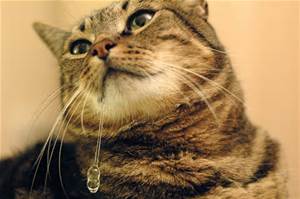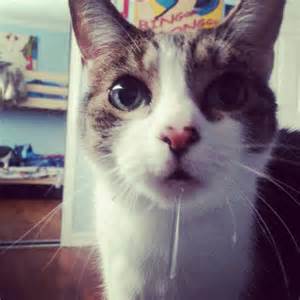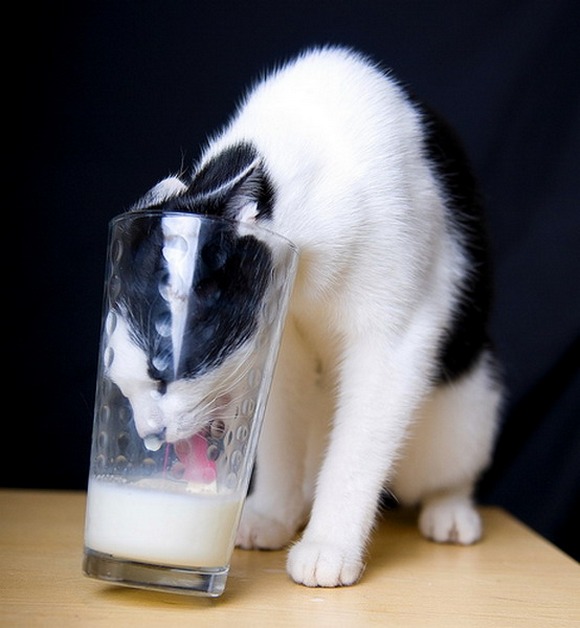By Dr. Becker and Diane Weinmann
One of the most memorable quotes from the 1993 movie “Homeward Bound: The Incredible Journey” is spoken by Sassy the cat, who tells Chance the Bulldog, “Cats rule and dogs drool.”
When Chance brushes off such a notion, Sassy explains, “But it’s true. Cats are smarter than dogs, and more attractive … and we don’t drink from the toilet!” Someone needs to tell Miss Sassy that in fact, members of her species do drool (and some even drink from the toilet) and some even use the toilet to eliminate!
If you have a feline dribbler on your hands, you’re not alone. Kitties drool for a variety of reasons. However, there are only a few truly benign causes of drooling in a cat.
Some kitties drool when they’re purring and feeling very content. Others drool when they “make biscuits” (knead). Many cats drool while enjoying a bit of catnip.
A cat who drools at any other time, or a lot of the time, warrants a visit to the veterinarian. Potential serious causes of excessive salivation include:
- Dental or oral disease
- Chronic kidney disease
- Poisoning
- Trauma or foreign body
- Motion sickness/nausea
Dental or Oral Disease
A mouth problem is by far the most likely cause of kitty’s excessive drooling. He could have a buildup of plaque and tartar. His gums could be inflamed or infected (gingivitis). Or his dental disease could be so advanced that he’s experiencing bone loss.
Another problem called tooth resorption can also cause drooling. Tooth resorption is the gradual destruction of a tooth or teeth caused by cells called odontoclasts.
Often an affected cat will drool, bleed from the mouth, and/or have difficulty eating. Occasionally there can also be vomiting of unchewed food, behavior changes, and bad breath.
Another oral disease with similar symptoms, including drooling, is feline stomatitis, a very painful and chronic condition that is thought to be autoimmune in nature. An affected cat’s immune system seems to overreact to dental plaque around the teeth, which triggers inflammation in the tissues of the mouth.
Stomatitis can also occur at the back of the throat at the oral pharynx, and underlying bone in the mouth can become inflamed or infected. The inflammation appears as angry, red, and swollen tissue in the cat’s mouth.
Another mouth problem that can cause drooling, especially in older kitties, is an oral tumor, which can be either benign or cancerous.
If your cat has chronic kidney disease (CKD), it means the kidneys have been gradually and irreversibly deteriorating over a period of months or years. Sadly, CKD is extremely common in older domestic cats and is a leading cause of death in kitties. In fact, I lost my cat, Milo to this awful disease, although my cat did not drool.
Symptoms of failing kidneys can include increased thirst and urination, leaking urine (especially at night), vomiting, diarrhea, lack of appetite, weight loss, depression, anemia, and overall body weakness.
Other signs of kidney disease can be fractures resulting from weakened bones, high blood pressure that can lead to sudden blindness, itchy skin, bleeding into the stomach, bruising of the skin, and painful sores on the tongue and gums that cause excessive salivation and drooling. Just remember that your cat does not have to have all of the symptoms to have kidney disease.
Cats with kidney failure are also often dehydrated, which causes drooling. If you suspect your kitty is having kidney problems, it’s important to make an appointment with your veterinarian as soon as possible.
If your pet’s kidney disease is the result of irreversible kidney damage, in many cases renal function will stabilize for weeks or even months at a time. The disease will continue to progress and kidney function will continue to deteriorate, but your cat’s symptoms can be minimized with supportive treatment.
Fluid therapy is the cornerstone of treatment for animals with kidney failure, primarily to prevent dehydration. Subcutaneous (under the skin) fluid delivery may be necessary, and many pet owners can learn to do this at home.
Poisons
Almost any type of toxin your cat is exposed to can make her drool. A short list of examples:
| ✓ Lawn fertilizers and pesticides | ✓ Antifreeze |
| ✓ Nicotine products | ✓ Human drugs, especially topical medications |
| ✓ Certain plants containing insoluble calcium oxalate crystals (e.g., Peace Lilies and Schefflera) | ✓ Liquid potpourri |
| ✓ Laundry detergent pods | ✓ Household cleaners |
If you suspect your cat has ingested a poisonous substance, immediately call your veterinarian, a local emergency animal hospital, and/or a poison control hotline such as the ASPCA’s Poison Control Center at 1-888-426-4435. The hotline is answered 24 hours a day, 365 days a year.
Trauma or a Foreign Body
Cats allowed outdoors unsupervised are especially at risk for many threats to their safety and health. If a kitty roaming freely outdoors experiences head trauma as the result of being hit by a car or attacked by a dog, injuries to the jaw or temporomandibular joint that prevent the mouth from closing can cause heavy drooling.
Another serious situation that can cause a cat to drool is the presence of a foreign object lodged in the tongue, soft or hard palate, or the back of the throat. Kitties aren’t indiscriminate eaters like many dogs are, however, there are certain strange objects that seem to entice them, for example, Christmas tree decorations, glow sticks and jewelry, and sewing needles attached to thread.
The best way to protect your cat from these types of injuries is to allow her outside only for walks with you on a harness and leash, or inside a safe feline-friendly enclosure. It’s also important to keep all indoor choking hazards out of reach of your kitty.
Motion Sickness/Nausea
It’s the very rare kitty who enjoys a car ride, and it’s not unusual for a cat who’s not used to traveling to develop motion sickness. It may not even be the movement of the vehicle that triggers nausea in your cat — it could just as easily be the stress she’s experiencing. My Milo hated the car- in fact all my cats hated traveling in a car.
Cats prefer to stick close to home and feel threatened by unfamiliar places, sights, sounds, and smells. They like to feel in control wherever they are, which is why being held hostage inside your car as it zips down the highway is so stress-inducing for kitty. One of the first signs your cat is feeling nauseous is excessive drooling. Other symptoms include loud crying, fear-induced immobility, urinating or defecating, and of course, vomiting or regurgitation.
Bach Flower essences, including Rescue Remedy can be beneficial in helping to calm a frightened or stressed-out cat. Administer 4-5 drops directly in your cat’s mouth about 10 minutes before you need to put them in the car. If they are still stressed out you can give another 4-5 drops more as you cannot overdose them and the drops do not interact with any other medications your cat may be taking; therefore, they are safe. In addition, Feliway is a calming pheromone product that you can spray in the cat carrier 15 minutes before you put your kitty in it for travel.
If your cat is having episodes of drooling at home, combined with a reduced appetite or vomiting it’s important to find out why by making an appointment with your vet. I wish I would of taken my cat sooner to the vet. Maybe the eventual outcome would have been different.

